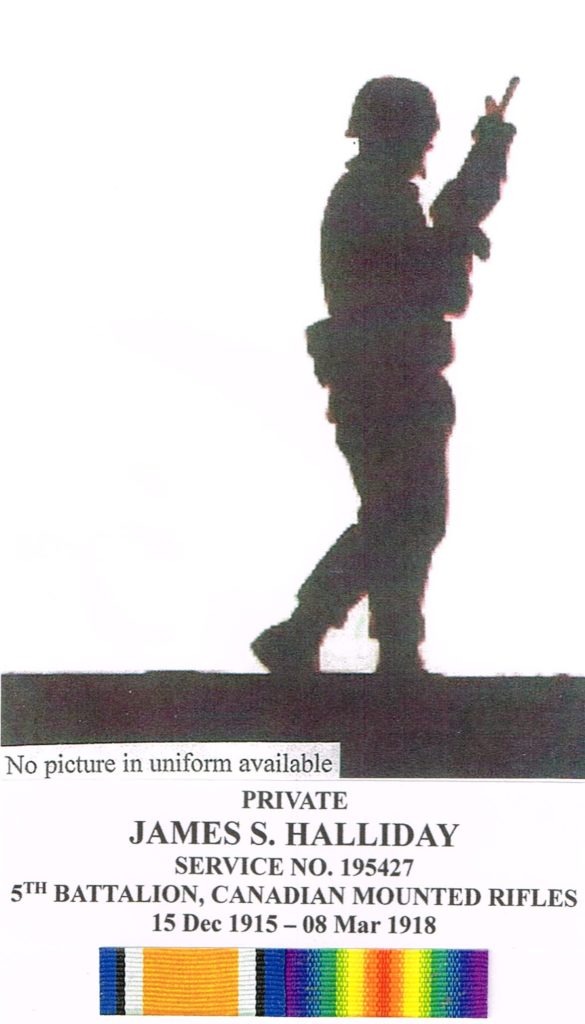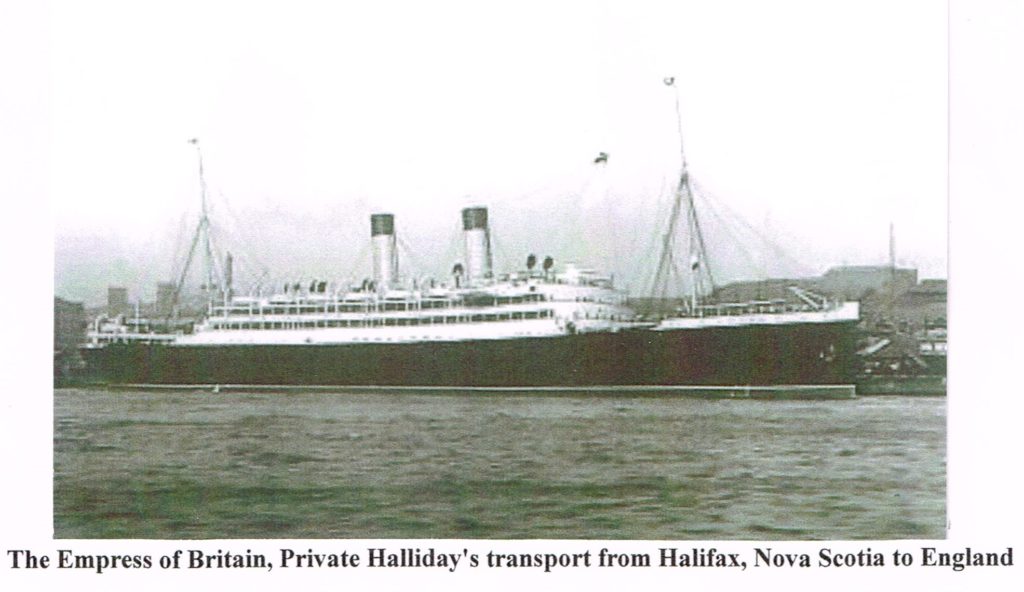MILITARY HISTORY
Private James Halliday – 195427 – ACTIVE SERVICE (World War I)
On December 15, 1915 James Halliday completed the Attestation Paper for the Canadian Army, Canadian Expeditionary Force (CEF) in Peterborough, Ontario. He was 30 years and 10 months old when, as a single man he enlisted for the duration of the War. James was born in Lockerbie, Dumfriesshire, Scotland. He gave his birth date as February 1, 1883. James indicated; he did not presently belong to an Active Militia but that he did have 5 years previous experience with the King’s Own Scottish Bords. There is nothing on his File to indicate where he was educated or to what level. As far as his Trade or Calling is concerned, he lists Farm Labourer. James was 5′ 5” tall, with a 36” chest (expanded). There is no indication of his weight. He had a dark complexion, with brown eyes and dark brown hair. His Medical Examination was completed December 15, 1915 in Peterborough; it indicated he had a tattoo of “J H” on his left forearm, no medical issues or physical limitations and as such he was deemed fit for Overseas duty with the CEF. His next-of-kin was listed as a cousin, Mrs. William S. Lee of RR #4 Peterborough, Ontario. James Halliday signed the Oath and Certificate of Attestation on December 15, 1915 in Peterborough. Initially, He was taken-on-strength, as a Private (Pte) with the 57th Regiment, and was assigned Service Number 195427. When the 93rd Battalion (Bn) was authorized and formed up, in Peterborough on December 22, 1915, Pte Halliday was transferred over and taken-on-strength with this Unit.
The 93rd Bn, after training through the winter and spring at 5 different area Centres, departed by train from Peterborough on May 29, 1916. The Battalion made a short stop at Barriefield Camp located at Kingston, Ontario before moving on to the main CEF Training Centre located at Valcartier, Québec. Valcartier was erected as a Military Base in August 1914, as part of the mobilization of the CEF, at the outset of World War I. The Base was located approximately 16 miles north of Québec City, Québec. The facilities and training were pretty rudimentary; training consisted of marching, rifle and bayonet drills. The Officers actually practiced swordsmanship. June 23, 1916 James indicated that he had insurance with the Canadian Order of Oddfellows and the Manufacturers Life Insurance Company. He also indicated that he had made arrangements for payment of his Insurance Premiums. The main goal of the Base was to form the men into Units and ship them off to England, as quickly as possible. Pte Halliday and the 93rd Bn embarked from Halifax, Nova Scotia, on July 15, 1916, aboard the SS Empress of Britain.
The SS Empress of Britain docked at Liverpool, England on July 25, 1916. There is no indication in his Military File as to where Pte Halliday and the 93rd Bn were barracked from July 25, 1916 until September 7, 1916. On September 7, 1916 he was transferred from the 93rd Bn to the 5th Bn, Canadian Mounted Rifles (CMR) at Otterpool, England. On September 8, 1916 he landed in France and was taken-on-strength with the 5th Bn, CMR. September 25, 1916 Pte Halliday left for the Canadian Constructional Engineers (CCE) Bn. September 28, 1916 he arrived in the Field and on October 2, 1916 Pte Halliday left for and joined the 5th Bn, CMR in the Field.
November 20, 1916 Pte Halliday had multiple ulcers on his leg; he was admitted to the No 8 Canadian Field Ambulance (CFA) with a tuber ulcer on his right shoulder (later denied). December 2, 1916 he was discharged from the No 8 CFA and admitted to No 10 CFA and was moved to the Convalescent Camp at No 10 CFA.
January 10, 1917 Pte Halliday was discharged from the Convalescent Camp at No 10 CFA and rejoined the 5th Bn, CMR in the Field. January 31, 1917 there was ulceration and he was admitted to the No 9 CFA with multiple ulcers. February 9, 1917 Pte Halliday was discharged from No 9 CFA and admitted to the Corps Rest Station (CRS). February 20, 1917 Pte Halliday was discharged from the CRS and rejoined the 5th Bn, CMR in the Field. March 10, 1917 he was admitted to Hospital with Scabies. March 12, 1917 Pte Halliday is admitted to the No 20 General Hospital at Camiers, France with Nephritis. March 16, 1917 he was diagnosed with Nephritis (inflammation of the kidneys) and was sent to No 2 General Hospital (GH) in England from the Dieppe Headquarters (HQ); on the same day Pte Halliday was taken-on-strength to the 2nd Québec Regimental Depot (QRD) at Shoreham from the No 2 GH. March 17, 1917 he is admitted to the Wharncliffe War Hospital (WWH) at Middlewood Rd., Sheffield, England.
On May 7, 1917 Pte Halliday was discharged from the WWH and was admitted to the King’s Canadian Red Cross Convalescent Hospital at Bushey Park, England with Nephritis (inflammation of the kidneys). On July 11, 1917 Pte Halliday was struck-off-strength from the 2nd QRD to the 1st QRD at Shoreham and was taken-on-strength the same day. May 18, 1917 Pte Halliday is discharged from the King’s Canadian Red Cross Convalescent Hospital at Bushey Park. On August 20, 1917 he was placed On-Command to the Canadian Discharge Depot (CDD) at Buxton, England. August 21, 1917 Pte Halliday was taken-on-strength to the CDD.
On September 13, 1917 Pte Halliday embarked at Liverpool, England for Canada, no ship name was provided. He disembarked at Halifax, Nova Scotia about September 22, 1917. September 25, 1917, at Medical District No 3, Kingston, Pte Halliday was discharged from the Depot to convalesce at home.
On September 28, 1917 a Medical Board was done for Private James Halliday, reference his Nephritis. All of the following statements are in respect to the Queen’s Military Hospital Commission of Canada (MHCC) Centre at Kingston.
October 6, 1917 – at the Queen’s as an Outpatient,
October 23, 1917 – admitted to Queen’s,
December 12, 1917 – admitted to Queen’s,
January 4, 1918 – admitted to Queen’s
February 5, 1918 – gambling in the Hospital; forfeits 5 days pay, and
March 8, 1918 – recommended for discharge from the Service.
October 6, 1917 Pte Halliday was an Outpatient at the Queen’s *Hospital under the MHCC at Kingston due to effects of Nephritis. October 23, 1917 — struck-off-strength (discharged) from the Queen’s Hospital under the MHCC at Kingston, Ontario.
November 7, 1917 Pte Halliday had an eye examination which resulted in him needing glasses.
December 21, 1917 Pte Halliday was an Outpatient at the Queen’s Hospital under the MHCC at Kingston.
March 6, 1918 Pte Halliday’s “last pay” was calculated at Kingston as $20.80.
On March 8, 1918 Private James S. Halliday was discharged from the Canadian Army (Active) at Kingston as being ”medically unfit for further War Service”.
There is no reference in the Military File as to which Decorations or Medals that Private James S. Halliday was eligible to receive, however he would have received the:
British War Medal 1914 – 1920; and
Victory Medal.
He also qualified for War Service Badge CEF Class “B”.
Private James Halliday’s medals/decorations were dispensed to him on June 8, 1922.
Based on his Military File, Private James S. Halliday served a total of 2 years, 2 months, and 21 days with the Canadian Expeditionary Force: 1 year and 14 days in Canada, 1 year 10 days in England, 6 months and 9 days in France and 19 days travel time.
Note: Private James S. Halliday’s calculation of “total time served” is based on his discharge from the Canadian Army date of March 8, 1918.
*The Military Hospital Commission of Canada (MHCC) was “set-up” so the Veteran could get treatment for his/her medical condition which caused his/her release at no cost to the Veteran.
March 11, 1919 he is discharged from the Queen’s MHCC.
August 7, 1919 Pte Halliday is admitted to the Queen’s MHCC with Nephritis, then on August 12, 1919 he is discharged to the Base Planning Committee (BPC).
An excerpt from an article in Maclean’s Magazine by Barbara Ameil, September 1996:
”The Military is the single calling in the world with job specifications that include a commitment to die for your country. What could be more honourable”?
PERSONAL HISTORY
JAMES S. HALLIDAY
James Halliday was born in Lockerbie, Dumfriesshire, Scotland on February 1, 1883. He was raised by his mother Barbara but didn’t know his father. James immigrated to Canada and came to the Lakefield area to stay with his cousin, Mrs. William Steven Lee (Jane “Jennie” Graham) who lived at the corner of the 6th line of Smith and Lakefield highway. James found work at the Lakefield Cement Works as a cement maker and helped on the farm. He attended Knox Presbyterian Church in Lakefield with the Lee family.
In December 1915, James went to Kingston to enlist to serve his King and Country. James spent over two years serving overseas and developed ulcers and suffered with chronic Nephritis. These medical issues resulted in James being discharged because of his medical conditions.
James S. Halliday was a member of Knox Presbyterian Church and is included on a Memorial Plaque that hung in Knox Presbyterian Church which remembers with honour their members who served in the Armed Forces during World War I. This plaque was later moved to the Sanctuary of Lakefield United Church on Regent Street in 1932 after the two churches merged to form Lakefield United Church.
THE JAMES S. HALLIDAY FAMILY HISTORY OF LAKEFIELD
Little is known about James Halliday’s family other than his mother’s name was Barbara Halliday and lived in Lockerbie, Dumfriesshire, Scotland. When James was interviewed after enlisting in the Army we learn that in 1916 his mother was living in Gilmour Cleugh, Scotland.
In 1917, James mother’s is referred to as Barbara Wilson and living in Gilmour Cleugh, Scotland. It is believed that she passed away near the end of World War I.

